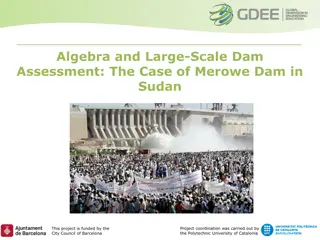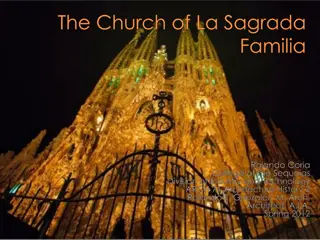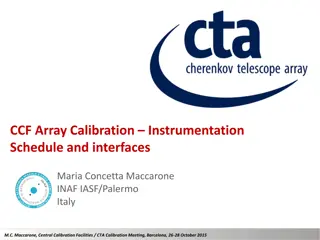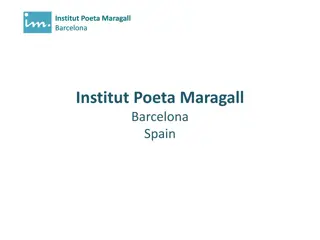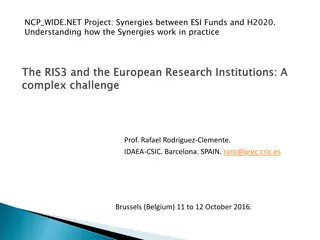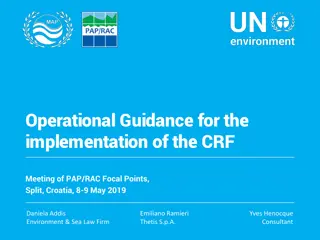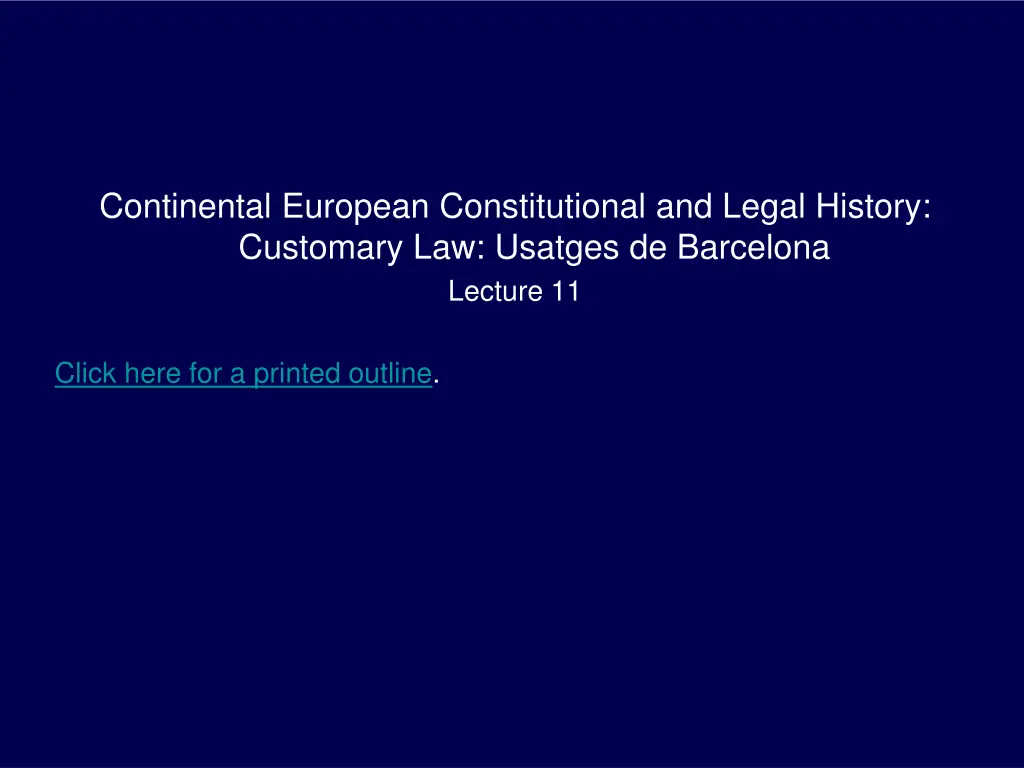
Customary Law in Continental European Legal History
Explore the growth of courts, customary law, and a chronology of custumals in Continental European legal history. Learn about the characteristics of English and French custumals and the evolution of legal systems in the 12th and 13th centuries.
Download Presentation

Please find below an Image/Link to download the presentation.
The content on the website is provided AS IS for your information and personal use only. It may not be sold, licensed, or shared on other websites without obtaining consent from the author. If you encounter any issues during the download, it is possible that the publisher has removed the file from their server.
You are allowed to download the files provided on this website for personal or commercial use, subject to the condition that they are used lawfully. All files are the property of their respective owners.
The content on the website is provided AS IS for your information and personal use only. It may not be sold, licensed, or shared on other websites without obtaining consent from the author.
E N D
Presentation Transcript
Continental European Constitutional and Legal History: Customary Law: Usatges de Barcelona Lecture 11 Click here for a printed outline.
The growth of courts:12th and 13th centuries Legislative, executive, and judicial in this period, perhaps even today, are not sharply separated, they form a spectrum. The same can be said about political and legal. At the very highest level no one forgot that the king or the pope was the greatest judge of all, and to give judgment in the central assembly was the most solemn kind of judgment one could give.. The 12th and 13th centuries also see a multiplication of judges associated with the growth of administration. By the middle of the 13th century every bishop in the West had his own court, staffed by a professional called the official. We are least well informed about justice at the lowest levels, particularly in rural areas, but it did exist.
Customary law Secular courts did not apply only customary law. The problem of definition. The anthropologists definition of customary law won t quite do because: There were written records There was written law Academic study of law was happening But some of the elements of the anthropologists customary law were there. The earl of Warenne and the quo warranto inquiries of Edward I. Efforts were made to preserve the customary system by writing it down in books of customary law, custumals (coutumiers, fueros).
A chronology of custumals (details on the outline) The English are the earliest: Glanvill before 1189, and much of Bracton by the 1230 s. This is not surprising granted the early development of English institutions. The Norman are the next, and they overlap chronologically: the Tr s ancien coutumier around 1200 and the Summa de legibus around 1250. They differ from Glanvill and Bracton in that they make more effort to state substantive rules and in that Roman law influence is less obvious. There is also less about the writs. The difference is one of degree, however, and not of kind. The four great French custumals from the end of the 13th century (Pierre de Fontaines, the Livres de jostice et plet, the tablissements de Saint Louis, and Beaumanoir) are all like Bracton in the sense that they attempt to integrate Roman and canon law. Pierre des Fontaines and Beaumanoir are also like Bracton and Glanvill and unlike the Norman custumals in that there is an authorial voice. As in England, so too in France, the 14th century brings a departure from the learned law, but the glossed coutume of Burgandy is an exception. .
Characteristics of the English and French custumals Most of them seem to be connected with specialization and teaching if not professionalization. Glanvill and Bracton are consciously trying to describe the custom and practice of the king s central royal court, a relatively new institution at the time that they write and one that is greatly expanding. The first Norman custumal may be associated with an attempt to write down the rules for English administrators; the second is probably to be associated with an attempt to give guidance to the French royal bailli. Pierre des Fontaines and Beaumanoir were both royal baillis and were almost certainly trying to describe a jurisdiction that their successors would have to administer. The Livres de jostice et plet and the tablissements de S. Louis are more complicated but may be connected with law study at Orl ans.
Characteristics of the English and French custumals (contd) Every one these documents is affected by Roman and canon law. Glanvill, Bracton and the Norman ones are written Latin. All of them make reference to ecclesiastical institutions and thereby indirectly to canon law. Beyond that the amount of the learned law in them and they way in which it is used varies considerably. Bracton and the Livres have the most Roman and canon law in them, citing it frequently and consciously making comparisons. Glanvill, Pierre des Fontaines, and Beaumanoir are further away, though they all know some Roman and canon law and it affects their habits of thought. Intellectual influence is harder to see in the Norman custumals and the tablissements.
Chronology of custumals (contd): the fueros (see outline) The word is not coutume or coutumier but fuero. The word is derived from Latin forum and originally means a court, but the Spanish always have a notion that the fuero is in some sense promulgated by a king. Once promulgated, however, it becomes the privilege of the area for which it is promulgated. There are fueros for particular towns, a great many of them. Any town worthy of the name in medieval Spain had its own fuero. Certain types of people would have their own fuero. The fuero viejo of Castile in its original form was probably a fuero for the nobility. There were fueros for mozarabs, Christians living under Moslem rule, and for mudejars, Muslims living Christian rule. The continued vitality of the Visigoth code had considerable effect. Ferdinand III gave the fuero juzgo to many of the towns that he refounded in the areas that he took from the Moors.
Chronology of custumals (contd): the fueros (see outline) By the middle of the 13th century the Castilian monarchs came to regard the diversity among the fueros as a problem. It is difficult to organize a kingdom that is subject to a multiplicity of laws, and in Castile, precedent, fazanya, was also recognized as a source of law. Ferdinand III s giving of the fuero juzgo to the newly reconquered cities was probably an effort at unification. The fuero real the first effort of his son Alfonso X (el Sabio) was clearly designed to restrict the privileges of the nobility and to get some unity in the law. Alfonso gave this fuero to a number of cities. It may have applied in the central royal court, a court of appeal in Castile, as in France. It would seem, however, that it was not until the Alfonso XI (1311 1350) that the fuero real came to have a more general applicability and even here it was only in the absence of a specific provision in a local fuero.
Chronology of custumals (contd): the fueros (see outline) Alfonso X did not stop at the fuero real. He also had compiled large book about law in general. The work was reedited into seven parts and has been known ever since as the Siete Partidas. It is written in the vernacular and is quite comprehensive. It is of great importance for Spanish legal history. I have chosen, however, not to extract it in the Materials for two reasons: (1) What it says about witnesses, marriage and wild animals simply repeats the rules of the academic law, as it does in many other areas. (2) There is no evidence that it was ever used as a working law-book in Alfonso s time. Indeed, there is considerable evidence that it was not even regarded as authoritative in the courts until 1348, and then it was only a secondary authority. The work is, however, a political statement that the only way for Spain to achieve legal unity and legal unity is intimately connected with political unity is by the use of the academic law. This is a theme that will become more and more important as time goes on; it seems to have appeared first in Spain. The realities, however, in the Iberian Peninsula in the 13th century were considerably messier. There was no political unity even within the individual kingdoms, and there were four of them.
The Usatges de Barcelona The Usatges de Barcelona (Mats., 10) shows us a coutume that probably was being used in the 13th century, though we must puzzle over exactly how it was being used. The word usatges is interesting. It is much closer to coutumier than fuero. What we are looking at is probably a redaction of the mid-twelfth century containing material that is considerably older, some of which probably goes back to the eponymous Raymond Berenguer I in the mid 11th century. Most of the scholarly effort with this document has been with recovering the earliest material. My efforts with it in connection with producing a translation for this class have suggested to me that some of it, perhaps a quite a bit of it, is probably later than the mid 12th century. I m encouraged in this by the fact that the most recent editor of the text agrees with me, but not everyone agrees with him. The document continued to be promulgated and copied throughout the Middle Ages.
The Usatges de Barcelona (contd) 14th c. manuscript of the Usatgesde Bacelona with a promulgation decree by Alfonso III, king of Aragon, 1285-1291
The Usatges de Barcelona (contd) 1702 (?) edition of the Usatges de Barcelona, with the promulgation decree (1413) of Ferdinand I, king of Aragon (1412 1416).
The Usatges de Barcelona (contd) The text was probably not fixed until the fifteenth century. With that kind of a history we should not expect that there will be much order in the materials. The only discenable order is that the earlier provisions tend to be in the earlier chapters and the later ones in the later chapters.
The Usatges de Barcelona: the beginning 1. Before the usages were issued, so that all misdeeds might always be emended if they could not be ignored, the judges used to judge by oath and by battle or by cold or hot water, saying thus: I (name) swear to you (name) by Jesus God and these four holy gospels that the evil that I have done to you I have done by my right and your wrong (a mon dret et ton tort); and I would stand to battle about this or to one of the above-said judgments, of cold or hot water. 2. Homicide and adultery which cannot be neglected were adjudged according to the laws and customs and emended or vindicated.
The Usatges de Barcelona: the beginning 3 [2]. When the lord Raymond Berenguer the old, count and marquis of Barcelona and subjugator of Spain, had the honor, he saw and recognized that the Gothic laws could not be observed in all causes or businesses of this country . He also saw many quarrels and pleas which these laws did not specifically treat or adjudge. With the advice and counsel of his upright men, along with his most prudent and most wise wife, Almodis, he constituted and published usages by which all quarrels and evils inserted in them were controlled, pleaded, judged, and also emended and vindicated. The count did this by authority of the Fuero juzgo which says: Clearly, the prince shall have license to add to the laws if just cause of novelty requires it. And let it be treated by the discretion of royal power how the new case shall be inserted into the laws. [2.1.13] Only the royal power shall alone be free in all things whatsoever penalty he commands be put in the pleas. [2.5.8] And the usages that he issued begin thus:
The Usatges de Barcelona: the beginning 4 [3]. These are the practices (usualia) of court usage that the lord Raymond the old, count of Barcelona, and his wife Almodis constituted to be held forever in their country, with the assent and acclaim of the magnates of the land, to wit: ... . [Nineteen names follow, three viscounts and sixteen men described as judges. ] [4]. Whoever kills a viscount or wounds or dishonors him in any way shall make amends to him as for two comdors [a mid-ranked Catalan nobleman] and a comdor like two vavassors. 5. Concerning a vavassor who had five knights, he shall emend for his death with 60 ounces of seared gold [a Muslim coin] and for a wound with 30 ounces. If he has more knights, the composition shall grow according to the number of knights. Whoever kills a knight shall give 12 ounces of seared gold in composition. Whoever wounds shall emend to him with 6. Clearly, there s a problem with the transmission, though not so great that one can t guess about origins. A probably accurate description of an ancient form of proceeding, coupled with the statement that the usages abolished them, which they clearly did not, see, e.g., c.112:
The Usatges de Barcelona: the beginning Husbands can accuse their wives of adultery by suspicion, and they ought to purge themselves by an avagant[ champion ; emend to averamentum and translate by affirmation ], by oath, and by battle, if there are manifest indicia and competent signs in it: the wives of knights by oath and also by a knight, the wives of citizens and burgesses and noble bailiffs by a foot- soldier, the wives of peasants [rusticorum] by their own hands by the cauldron. . . . I think that the prelude is 12th century, and it reflects the concern of the period with making the procedure more rational. The document which purports to be adoption document looks largely genuine. The substantive core of material that looks like an attempt to integrate feudal institutions into the wergeld system of the fuero juzgo. This may well be from the mid 11th century.
The Usatges de Barcelona: witnesses The provisions about witnesses suggest a gradual acceptance of the Romano-canonical scheme. The beginning is clearly in c.57 where witnesses are being used instead of battle, apparently, for the situation in which the tenant is not in possession. 57 [54]. Fees which knights hold, if their lords deny that have given them to them, they shall aver them by oath and by battle and shall have them. Those which they do not hold and claim [read do not hold but claim ], they shall either prove by witnesses or by writing that they acquired them from their lords, or they shall abandon them. Even here we must be careful. Witness procedure is mentioned in the Fuero juzgo, and the man who wrote the dissertation on the topic found some documents as early as the 11th (?) century that mention them. It is tempting to see the distinction here as being like that of writ of right and novel disseisin in England. In any case this is the base case. It s the only one that the most recent editor includes in his edition of the base (mid- 12th century) text.
The Usatges de Barcelona: witnesses (contd) 85 [B2]. We command in order that perjuries be guarded against [that] witnesses not be admitted to take an oath before they are examined. If they cannot otherwise be examined, they shall be separated from each other and examined singly. The accuser may not chose witnesses in the absence of the accused. In no way shall anyone shall be admitted to the oath and to testimony unless he is entirely fasting. If a witness is recused, let him who is recusing say or prove why he ought not be received. Witnesses shall be chosen from this territory and not from another, unless the case must be investigated far from the county. If anyone is convicted of perjury, let him lose his hand or redeem it with 100 shillings. [Parallels: C.3.20.14; C.22 q.5 c.6; X 2.20.2; MGH, Capitularia regum francorum 1.124 (805); P. 310 12.9] [The texts of cc. 86 88 can be found on the outline.]
The Usatges de Barcelona: witnesses (contd) 89 [B6]. Accusers and witnesses cannot be those who a day or two before were enemies, lest in their wrath they seek to harm and lest the injured seek to avenge themselves. An unoffended affect [inoffensus effectus] is to be sought in accusers and witnesses, not a suspect one. Suitable witnesses are not those who can be ordered to be witnesses. [Parallels: D.22.5.3, .5; P. 317.] The substance of cc. 85 89 can all be found in 11th century canonical collections and they are largely drawn from Pseudo-Isidore. C.89 probably requires a more profound knowledge of Roman law, though it could be by way of proceduralists, like Tancred. It is possible that these provisions date from the mid-12th century, but it seems unlikely, both because they are not in all the early mss. and because the effort that would have been necessary to put them together from existing sources in the mid-12th century is probably beyond the folks that were putting this material together.
The Usatges de Barcelona: witnesses (contd) 143. Because we have frequently received complaint by our subjects that truth is obscured and repressed by the corruption of witnesses, following in this part the imperial laws, we order that if any witness be produced by anyone he shall be bound by oath that no money or anything else was given or promised to him nor, to his knowledge, to anyone subject to him. Further, to put an end to the slipperiness of witnesses (testium facilitate) by which the contrary to the truth is put forward, we order that anyone litigating before us or anyone delegated by us who knowingly produces a false witness or corrupts a witness shall lose his cause and shall incur the publication [sic, probably means a type of forced sale] of all his movable goods, of which one-half shall be assigned to his lord and the other half shall be kept in our treasury. The same penalty of publication of goods shall be incurred by anyone convicted of having borne false testimony, and above that he shall lose his hand and his tongue, and the possessions [does this mean immovables?] of both shall devolve on those who are called to their goods by right of succession. [Parallels: D.22.5.5, .16, .3; P. 320 1.]
The Usatges de Barcelona: witnesses (contd) 144. Because we have frequently received complaint by our subjects that frequently in the courts cases are brought and defended calumniously; then appeals are taken from interlocutory [sentences], and as a result the matter at stake is long protracted and long suspended, so that scarcely or never can it finally be concluded; wishing therefore to counter this fraud and malice with a royal antidote and desiring to impose an end to quarrels, and so that the parties not be unjustly exhausted with labors and expenses, with the counsel and approval of the nobles and magnates and also of our citizens who at that time were present in our court we think that it ought to be laid down as follows: that from henceforth in all cases the oath of calumny shall be taken by both the plaintiff and defendant and that there be no appeal from interlocutory sentences, except from manifest harm, or unless it plainly contains error, or unless it is pronounced against right [jus]. In which cases, it shall be determined within three days about the aforesaid sentence and corrected as it ought, and so not only litigation but also calumniators shall be diminished. . . . [Parallels: D.49.5.12; D.22.5.21; P. 321.]
The Usatges de Barcelona: witnesses (contd) Cc. 143 144 are interesting because they are so clearly legislative (parallels of Innocent III?). In order to follow this form this carefully we need to have either the Code or papal decretal letters or both. (Even that needs to be checked out against the Visigothic examples.) The reference to slipperiness of witnesses (testium facilitate) is to me, at least, is some indication of 13th century origins (though the phrase does occur in the Digest), as is the efforts of both Innocent III and Innocent IV to limit frivolous appeals to the papacy. When this is combined with the fact that these texts are in none of the early manuscripts, we pretty clearly have reached another stage of development. Bottom line: With care but with some guess-work, it is possible to contstruct stages of the reception of at least the formal law of Romano- canoical procedure in Barcelona. To what extent this was reflected in the courts is question that might be answered (the Aragonese archives are very rich), but no one seems to have done the work yet. [The Materials have more provisions from the Usatges about witnesses.]
The Usatges de Barcelona: marriage 108 [85]. If anyone violently corrupts (violenter corruperit) a virgin, he shall either marry her if she and her parents wish and give her exovar [roughly, dowry or bride- price ], or he shall give her a husband of her worth. If anyone violently commits adultery with a woman who is not a virgin and impregnates her, likewise. [Parallels: Petrus, c. 54; Exod. 22:16 17 in X 5.16.1 (Ivo, Decret. 5.292 3); J.I. 4.18.4; Fuero juzgo 3.4.7; P. 284.] [ Adultery in the second sentence is adulterium in the text. We may doubt whether adultery in either the Roman or the modern sense is meant. DuCange, s.v., reports that the word adulterium is frequently used in the early middle ages as the equivalent of Latin stuprum, a word that normally often means corruption of a virgin, but that does not seem to be what is involved here. Compare Fuero juzgo 3.4.7, where the word adulterium is used where we would expect fornicatio.]
The Usatges de Barcelona: marriage (contd) The outline contains the texts of the parallel passages. They include a passage from the Exceptiones Petri, a handbook of Roman law for practitioners probably compiled in the early 12th century; there are other passages in the Usatges that seem to rely on the Exceptiones Petri. A passage from the Biblical book of Exodus. The passage appears, quite unusually, in the Decretals of Gregory IX, probably because it had not appeared in Gratian. It also appears in a canonical collection of the late 11th century attributed to Ivo of Chartres (Decretum 5.292 3). There is other evidence that the compiler of the Usatgesknew this work of Ivo s. Somewhat more distant in wording, but on the same topic, is a passage from Justinian s Institutes. Last, but certainly not least, there is a parallel passage in the Fuero juzgo, perhaps derived from the laws of the Visigothic king Euric (466 484).
The Usatges de Barcelona: marriage (contd) A few years ago, I gave c. 108 and the parallel passages as an hour exam in this course. I also included the provisions on raptus from Aehtelberht s laws and the Burgundian laws, provisions that we compared when we were studying those laws. The texts were passed out in advance but not the question. The question was: what is likely to have been in the mind of the compiler of the Usatges: Roman law? Canon law? Germanic law? All three? None of the above? In order to answer this question, I suggested a way to go about doing it: (1) Examine the texts given above carefully to see their similarities to and differences from the provision in the Usatges. (2) Outline an overall scheme that indicates how law and institutions are likely to have developed in the county of Barcelona by the middle of the twelfth century (at the earliest) or the mid-thirteenth century (at the latest). Both the analysis of the texts and the overall outline will then inform a final judgment as to what is going on in this text. Since we are fairly close to the hour exam, I would suggest that we do this in class. The law and graduate students don t take the hour exam, but doing this would be a good check, at about mid-course, on the method of the course and will likely help on the final exam.
The Usatges de Barcelona: marriage (contd) 109 [86]. Concerning the things and faculties of peasants who are exorchs [one ms. glosses as sterile ], those who have left this world, their lords shall have that part of their goods that their children [perhaps sons ] would have had if such had survived. There are no known parallels to this provision, in contrast to all the rest in this group all of which have parallels in the Fuero juzgo. That is encouraging. We may be dealing here with a real custom of 12th- century Barcelona. The peasants (rustici) of which the provision speaks are probably serfs, perhaps even in some sense slaves. The word exorch seems to be related to Latin extorquere, which means extort . What the provision seems to be saying is that if the peasant dies and is not survived by children, the lord gets that portion of the inheritance that would have gone to the children if any had survived. The fact that exorch is used to describe the practice suggests that those who used word did not regard the practice as altogether justified.
The Usatges de Barcelona: marriage (contd) 110 [87]. Similarly, concerning the things and possessions of adulteresses, if the adultery was committed their husbands unwilling, they and their lords shall divide the entire portion of the adulteress equally. If, on the other hand may it never happen the adultery was done by the will, order or assistance of their husbands, the lords shall have right and justice entirely. [Parallel: Fuero juzgo 2.4.12 [recte 3.4.12]; P. 285.] 111 [88]. If women do this not of their own free will but out of fear of and by the order of their husbands, they shall be immune from their husbands and lords and shall not lose any of their own goods, and if it pleases the same women they may separate from their husbands in such a way that they do not lose their dowry [dos] nor their spousal gifts [sponsalicia]. [Parallel: Fuero juzgo 3.6.5; P. 285.]
The Usatges de Barcelona: marriage (contd) 112 [89] Husbands can accuse their wives of adultery by suspicion, and they ought to purge themselves by an avagant[ champion ; emend to averamentum and translate by affirmation ], by oath, and by battle, if there are manifest indicia and competent signs in it: the wives of knights by oath and also by a knight, the wives of citizens and burgesses and noble bailiffs by a foot-soldier, the wives of peasants [rusticorum] by their own hands by the cauldron. If the wife wins, her husband shall retain her honorably and shall pay her all the expenses that her friends and relatives made in the plea and in the battle and the damage to the champion [bataier]. If she loses, she shall come into her husband s hand with all the goods that she has. [Parallel: Ivo, Decret. 4.20.si mulier; P. 319; Fuero juzgo 3.4.3; P. 285 6.]
The Usatges de Barcelona: marriage (contd) The parallels to these provisions in the Fuero juzgo are given on the outline. They are close enough that it seems clear that these provisions contain ideas, and in some cases words and phrases, that are derived from the Fuero juzgo. They are not the same, however. C. 110 seems to say that lords get part of the forfeitue and that they will be adjudicating cases of adultery. Lords are not mentioned in this context in the Fuero juzgo. The parallel to c. 111 deals not with adultery but with male homosexual acts. The specification of the procedure by oath and battle or ordeal in c. 112 is not found in the Visigothic parallel, which speaks simply of manifest indicia and competent signs, the same words that are found in c. 112.
The Usatges de Barcelona: marriage (contd) 147 [C4] If a widow lives honestly and chastely in her honor after the death of her husband, she shall have her husband s substance so long as she remains without a husband. If she commits adultery and violates the bed of her husband, she shall lose her honor and all the property of her husband, and the honor shall come to the power of her children [perhaps sons ] if they are of age or of their relatives, in such a way, however, that she shall not forfeit her property (suum), if she appears to have a present interest in it (si in presenti apparuerit avere), nor shall she lose her spousal gift (sponsalicium) so long as she lives; afterwards it shall return to the children or the relatives. [Parallels: Fuero juzgo 3.2.8, 4.2.14, 3.2.1; P. 289 90.]
The Usatges de Barcelona: marriage (contd) The manuscript tradition suggests that this provision is later than the ones about adultery. The parallel provisions in the Fuero juzgo, all of which are given on the outline, are, however, old. They even have parallels in the Burgundian laws. The meaning of adultery in this provision is unclear, and it is not completely clear in the parallels. The property arrangements for widows are also not completely clear, nor are they in the parallels. What is clear in c. 147 is that there is a category of property called an honor , not mentioned in the parallels. The widow forfeits the honor if she commits adultery , which may include simply remarrying. She also seems to have a life estate in at least part of what is not the honor.


